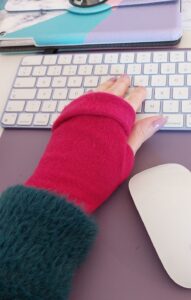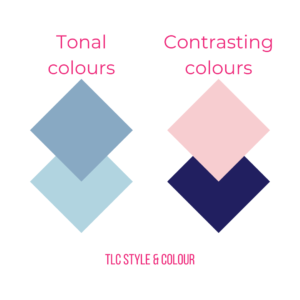Aside from the practicality of staying warm (heat the person not the home as Martin Lewis says), you can use layering to add interest as well as colour to your outfit.
It’s a very clever way of instantly looking more pulled together! It can also improve your £’s per wear on your clothes and help you get more wear out of what you already have in your wardrobe.
In the real world, it can feel tricky to pull off without feeling like Joey from Friends (the one where he wears all of Chandler’s clothes!)
Here’s my seven tips to help:
1. Choose fine, thin garments as layers
This avoids adding unnecessary bulk to your frame. Plus, it means you can add more layers if you need them.
As an example, think a top, jumper, with a blazer and a scarf.
2. Select your fabric wisely
Unsurprisingly, wool is a great insulator so a must for winter. In case you didn’t know; wool will keep you warm even when wet! Wool also comes from different sources and thickness. So, Herdwick sheep’s wool tends to be thicker and more course compared to merino sheep wool which tends to be finer (and therefore less irritating).

Cashmere is another fab choice but is not sourced from sheep so it is different to wool. It can be expensive, so if your budget doesn’t stretch, consider it in your accessories. I love my Turtle Doves cashmere fingerless gloves (featured below) which help to keep my hands and wrists warm.
Synthetic fibres aren’t breathable which means they trap heat in. Polyester, nylon and non-wool fleeces are examples of such fabric. Use them as an outer layer rather than as a base.
Silk adjusts to your body temperature and works in both hot and cold months. Makes it a great choice for increasing your £’s per wear and wearing items all year round.
3. Add interest to your outfit using colour
 There are lots of ways to wear colour (which you learn during a colour consultation) but here’s two ways.
There are lots of ways to wear colour (which you learn during a colour consultation) but here’s two ways.
Wear them tonally and in the same colour group (ie blues together, greens together etc.)
Or, wear them contrasting (ie a light and a dark colour). Here’s an example.
If you’ve had your colours done and looking for more ways to wear your colours, book an advanced colour session. Alternatively, register your interest here in colour analysis.
4. Wear different textures
Fabric will look and feel different depending upon the material. Using different textures in your outfit can add an element of luxury or interest. Try a cashmere jumper with denim jeans, a tweed jacket, leather boots and a silk scarf.
5. Be clever with your colours
Use them to colour block and take attention away from any problem areas you feel you have. So, if you’re conscious of an area, avoid wearing a light colour there as it can highlight it instead.
If you’re bigger busted, stick to lighter or brighter colours below the waist instead to draw the eyes and attention away from this area. You can also use print to detract attention though see point 6 below.
Those with an inverted triangle shape, wearing a short puffy jacket and chunky knit scarf will simply emphasise your top half with bulky layers. Instead consider elongating your height by wearing a longer line coat. By contrast, someone with a triangle or pear shape will find that layering on their top half will visually balance out their figure instead.
6. Finishing points like hems
Hems and edges which finish at narrow parts of your body will be much more flattering. Think sleeves ending at the wrists or just above. Hems on jackets finishing at your waist if you have a narrow, clearly defined one.
A horizontal line (even a stripe) which falls across your widest part like hips, bottom, thighs or shoulders can emphasise this if it’s one of your widest points of your body.
7. Strike a pose!
Whatever your shape, the best and easiest way to check if your outfit is causing you to look visually imbalanced or putting your proportions out is to take a picture. Ideally in a full length mirror, then check and see if visually, you are balanced and in proportion or out of proportion.
Here’s an example of layering:
Base layer: camisole, vest or thermal top
Second layer: a top, blouse, shirt or fine knit jumper
Third layer: blazer, cardigan or shacket
Fourth layer: gillet, coat*, jacket, poncho
*Finally, on the subject of coats, they are often one of your most expensive pieces. Revisit this video on choosing a winter coat where I share some coats from my own wardrobe and why they work to help inspire you.
